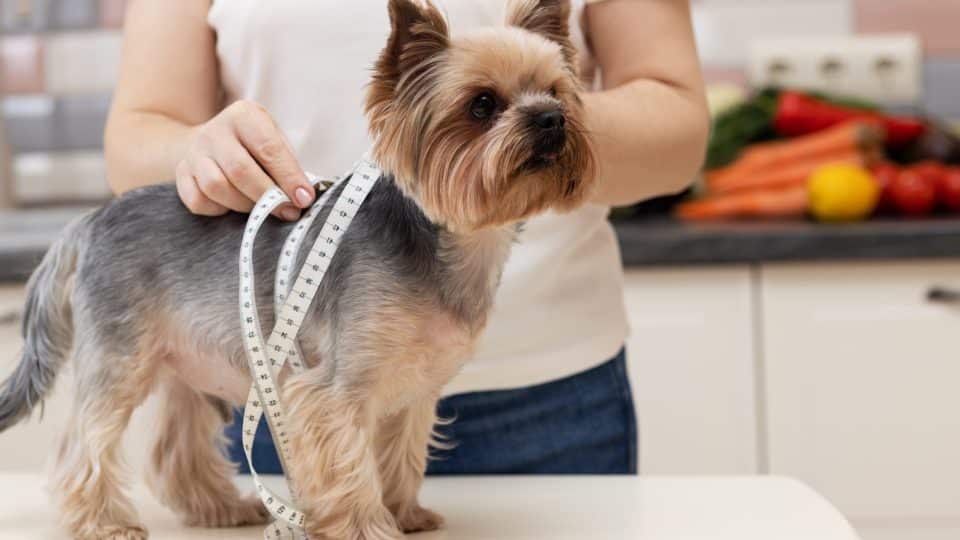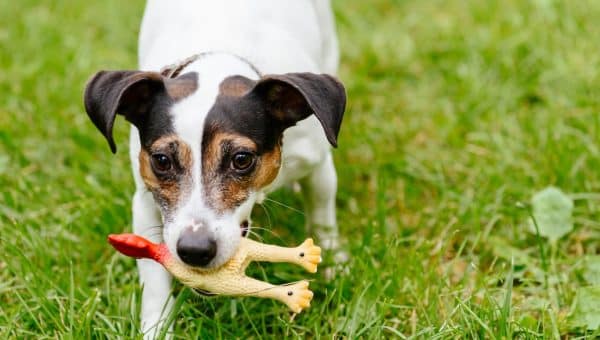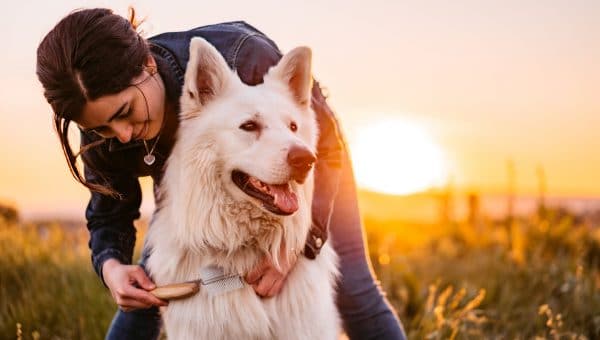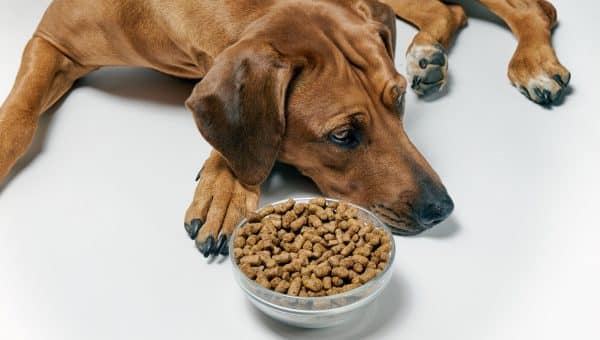- Not a substitute for professional veterinary help.
If your veterinarian recently told you your pup is one of many dogs who are overweight (over half in the U.S. are!) or you suspect your dog may be carrying a few extra pounds, it’s important to help them be as healthy as possible. Keeping your dog at or around their ideal weight can add years to your time together. The best dog weight-loss strategies involve a proper diet, meaningful exercise, and plenty of hydration.
Understanding how many calories your pup really needs to eat in a day is challenging, and it’s even easier to spoil your dog with too many treats. Pet parents aren’t alone in their struggle. It’s a problem veterinarian Dr. Nell Ostermeier knows all too well and, according to her, the most common mistake among pet parents that leads to weight gain in dogs.
Not to fret! In addition to tips from Dr. Ostermeier, we also spoke to a board-certified veterinary internist with a subspecialty in gastroenterology. Together, they’ve laid out everything you need to know to get your dog to a healthy weight and maintain it, starting with figuring out how much they should be eating.
Is My Dog Actually Overweight?
“A great way to assess if your pet is overweight or obese is to use a body condition scoring (BCS) system,” says Dr. Kelly Diehl, veterinarian, board-certified small animal internal medicine specialist, and senior director of science at Morris Animal Foundation.
Because there is no one-size-fits-all when it comes to a healthy dog weight, a BCS evaluates your dog’s physique by considering the feel of their ribs and visual assessment of their waistline. You won’t be alone in scoring your dog’s BCS. Your veterinarian will evaluate your dog using the same scale during annual or semi-annual checkups.
To simplify, Dr. Ostermeier says if you can’t feel your dog’s ribs or see the waistline, your dog is overweight; meanwhile, if you can feel your dog’s ribs easily and they feel sharp, your dog’s underweight.
Why Should Dogs Lose Weight?
Dogs at a healthy weight live longer and potentially happier lives. One study found clear evidence that dogs at a healthy weight live an average of 2.5 years longer than those who are overweight.
Researchers and veterinarians say that’s because overweight and obese dogs face an increased risk of developing a range of chronic diseases, including diabetes, some types of cancers, metabolic conditions, heart disease, and kidney disease.
Moreover, healthy dogs have a decreased risk of early onset conditions affecting their quality of life, such as arthritis. So, not only will they live longer, but they’ll have more years to enjoy doing the physical activities they love.
How to Create an Effective Weight Loss Plan For Your Dog
An effective weight loss plan for your dog depends on individual factors, like your dog’s overall health and any existing medical conditions, age, and the amount of weight they should lose. According to Dr. Diehl, a common mistake made by pet parents is assuming that merely placing their pet on a non-prescription, low-calorie diet is enough to sustain weight loss. Instead, she recommends working closely with your vet to create a weight loss plan. Here are four steps for crafting a sustainable long-term plan:
- Determine the ideal weight-loss food
- Calculate your dog’s calorie intake
- Incorporate exercises appropriate for your dog’s age and breed
- Keep your dog properly hydrated
Weight loss plans for dogs won’t aim for rapid weight loss. “When I am working with a pet parent on weight loss, we typically shoot for a 5% to 10% reduction in weight over one to three months,” Dr. Ostermeier says. She adds that this percentage depends on your dog’s specific needs, their willingness to adhere to a diet, and the pet parent’s dedication to the weight loss plan.
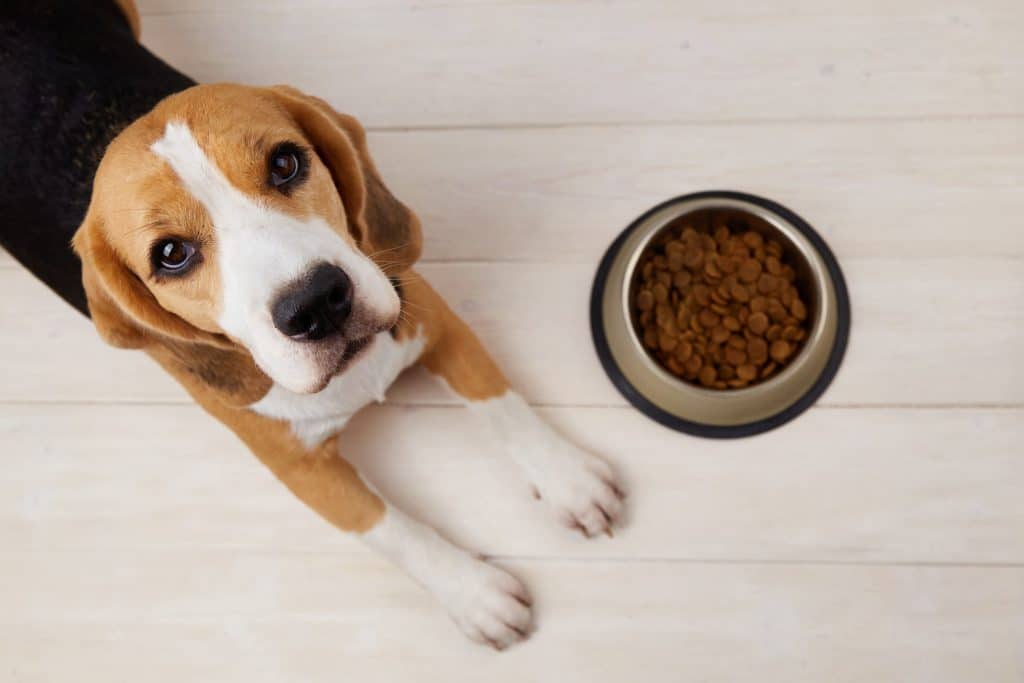
iStock/Viktoriya Telminova
What’s the Best Dog Food For Weight Loss?
There is no one best food for weight loss because the best choice for your dog depends on their personal taste preferences and management of any other health conditions. Nevertheless, the best dog foods for weight loss are generally:
- High in moisture
- High in fiber
- Low in calories
- Low in fat
Just as important as what you feed your dog is how much you feed them. Our experts suggest that while the guidelines on the back of pet food bags and cans are a good starting point, a more accurate approach involves calculating your dog’s calories based on weight and activity level, ideally in collaboration with your veterinarian.
Until you can chat with your vet, Dr. Ostermeier provides a useful formula to estimate your dog’s daily caloric needs: (Weight of your dog in pounds x 15) + 70 = number of calories (kcals) per day.
“If your dog is losing weight and that is not desired, increase their caloric intake by 10% increments,” she says. “If they are gaining weight and that is not desired, decrease the caloric intake by 10% increments.” Remember, treats count as calories. Dr. Ostermeier recommends splitting your dog’s daily food into two meals per day and allowing 5% to 10% of their calories to come from treats. Low-fat dog treats are great if your pup is on a weight-loss plan.
Which Exercises Are Best For Weight Loss?
Any boost in daily activities contributes to burning more calories. However, exercise doesn’t have to be complicated! Dr. Ostermeier recommends simply increasing the time you spend walking or playing with your dog every day.
Before increasing your dog’s activity or introducing a workout plan, talk to your veterinarian to determine if your dog is healthy enough and how much exercise they actually need. For example, your vet may recommend low-impact exercises such as swimming to alleviate pressure on your dog’s joints. Once you’re given the all-clear, here are some great ways to exercise with your dog:
- Practice stationary exercises (lunges, squats, push-ups, etc.)
- Attend dog-friendly yoga classes
- Go on a hike
- Take up running
- Increase your walking time

iStock/Prostock-Studio
Weight Loss FAQs
How can I monitor my dog’s weight loss?
Dr. Diehl recommends using the BCS (body condition score) scale to evaluate your dog’s progress at home. After consulting with your veterinarian, you can also track their progress toward their ideal weight using a bathroom or pet scale at home. Remember, gradual weight loss is the healthiest approach, so anticipate slow changes. If you observe sudden changes in your dog’s weight, work with your vet to reassess your dog’s weight loss plan.
How long does it take for dogs to lose weight?
Ideally, your dog should lose 1% to 4% of their starting body weight every 2 weeks (or about 0.5% to 2% per week and 2% to 8% per month). Like humans, weight loss for dogs might be faster at the beginning of their diet since they may be dropping water weight.
What if my dog suddenly lost weight?
If your dog is suddenly losing weight, see your veterinarian to rule out any underlying conditions. Dogs with a lack of appetite or those who have stopped eating for 24 hours should also be seen by a veterinarian. If weight loss and/or a lack of appetite is accompanied by other symptoms like vomiting or lethargy, seek immediate care from an emergency veterinarian.
How much should I feed my dog?
While the guidelines on pet food packaging offer a starting point, they are not the most accurate way to determine how much your dog should eat. For precision, calculate your dog’s daily caloric needs based on weight and activity level, preferably with guidance from your vet. Ostermeier provides a formula to use until you can talk with your vet: (Weight in pounds X 15) + 70 = daily calories. Additionally, if your dog is gaining or losing weight when not desired, Dr. Ostermeier says to adjust the caloric intake by 10% either way.
Lastly, allocate 5% to 10% of your dog’s daily calories for treats to prevent overfeeding.
Should I avoid free-feeding my dog?
Dr. Diehl says there’s no one right way to feed your dog. For example, she says if your dog has a medical condition, they might need a specialized diet and feeding schedule. That said, tracking your dog’s daily intake can become challenging when food is always available. Dr. Ostermeier suggests splitting your dog’s daily calorie needs into two timed meals, with 5% to 10% of calories allocated for treats.
Establishing a feeding routine can reduce anxiety and begging as dogs anticipate regular mealtimes. If your schedule is chaotic, invest in an automatic feeder so your pup gets fed at the same time each day.
